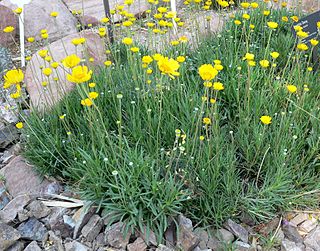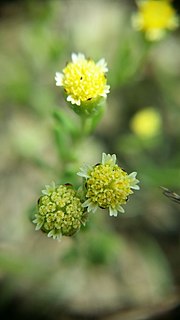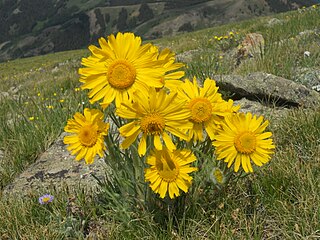
Oenothera biennis, the common evening-primrose, is a species of flowering plant in the family Onagraceae, native to eastern and central North America, from Newfoundland west to Alberta, southeast to Florida, and southwest to Texas, and widely naturalized elsewhere in temperate and subtropical regions. Evening primrose oil (EPO) is produced from the plant.

Hymenoxys is a genus of plants in the sunflower family, native to North and South America. It was named by Alexandre Henri Gabriel de Cassini in 1828.
Hymenoxys cooperi is a species of flowering plant in the daisy family known by the common name Cooper's rubberweed. It is native to the southwestern United States and Great Basin, where it grows in rocky soils in arid regions from southern California to New Mexico, north as far as Idaho and Oregon.

Hymenoxys lemmonii is a species of flowering plant in the daisy family known by the common names Lemmon's rubberweed, Lemmon's bitterweed, and alkali hymenoxys. It is native to the western United States in and around the Great Basin in Utah, Nevada, northern California, and southeastern Oregon.

Lactuca biennis is a North American species of wild lettuce known by the common names tall blue lettuce and blue wood lettuce. It is widespread across much of the United States and Canada from Alaska and Yukon south as far as California, New Mexico, and Georgia.

Tetraneuris, commonly known as four-nerve daisy or bitterweed, is a genus of North American plants in the sneezeweed tribe within the daisy family.

Hymenoxys texana is a rare species of flowering plant in the aster family known by the common names prairie dawn, Texas prairie dawn-flower, and Texas bitterweed. It is endemic to Texas, where it is known only from the general vicinity of Houston. It is threatened by the loss of its habitat. It is a federally listed endangered species of the United States.

Sara Allen Plummer was an American botanist and the wife of California botanist John Gill Lemmon. Mount Lemmon in Arizona is named for her, as she was the first white woman to ascend it. She was responsible for the designation of the golden poppy as the state flower of California, in 1903. A number of plants are also named in her honor, including the new genus Plummera, described by Harvard University botanist Asa Gray in 1882.
John Gill ("J.G.") Lemmon was an American botanist and Civil War veteran and former prisoner of Andersonville. He was married to fellow botanist, Sara Plummer Lemmon, and the two jointly cataloged numerous western and desert plants.

Tetraneuris acaulis is a North American species of flowering plants in the sunflower family. Common names include angelita daisy, stemless four-nerve daisy, stemless hymenoxys, butte marigold, and stemless rubberweed.

Hymenoxys richardsonii, the pingue hymenoxys or pingue rubberweed, is a North American species of plants in the sunflower family. It is widespread across the western United States and western Canada from Arizona, New Mexico, and western Texas north as far as Alberta and Saskatchewan.
Hymenoxys anthemoides, the South American rubberweed, is a South American species of flowering plants in the daisy family. It is native to Bolivia, Paraguay, Uruguay, and Argentina.
Hymenoxys ambigens is a species of flowering plant in the daisy family known by the common name Pinaleño Mountains rubberweed. It is native to the states of Arizona and New Mexico in the southwestern United States.
Hymenoxys bigelovii is a species of flowering plant in the daisy family known by the common name Bigelow's rubberweed . It is native to the states of Arizona, Utah, and New Mexico in the southwestern United States.
Hymenoxys brandegeei is a species of flowering plant in the daisy family known by the common names Brandegee's four-nerve daisy, Brandegee's rubberweed or western bitterweed. It is native to the states of Arizona, Colorado, and New Mexico in the southwestern United States.

Hymenoxys grandiflora is a North American species of flowering plant in the daisy family known by the common names graylocks four-nerve daisy, graylocks rubberweed, or old man of the mountain. It is native to high elevations in the Rocky Mountains of the western United States, in the states of Montana, Idaho, Wyoming, Utah, Colorado, and New Mexico.
Hymenoxys rusbyi is a North American species of flowering plant in the daisy family known by the common names Rusby's rubberweed or Rusby's bitterweed. It has been found only in the states of Arizona and New Mexico in the southwestern United States.
Hymenoxys subintegra is a North American species of flowering plant in the daisy family known by the common name Arizona rubberweed. It has been found only in the states of Arizona and Utah in the southwestern United States. Many of the populations lie inside Grand Canyon National Park, others in Kaibab National Forest.
Hymenoxys vaseyi is a North American species of flowering plant in the daisy family known by the common name Vasey's rubberweed. It is native to the southwestern United States, primarily in New Mexico with a few populations in extreme western Texas.
Hymenoxys robusta is a South American species of flowering plant in the daisy family. It has been found primarily in Bolivia with a few populations in nearby Peru and Argentina.









